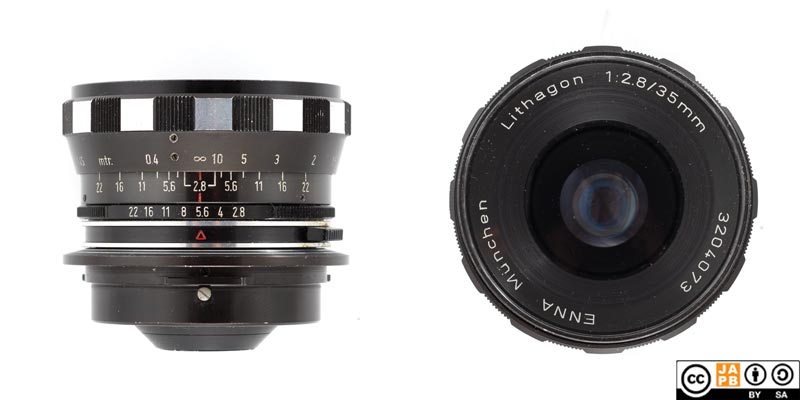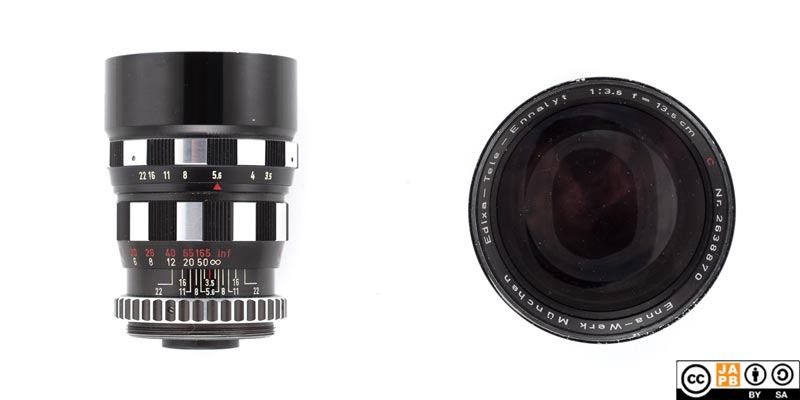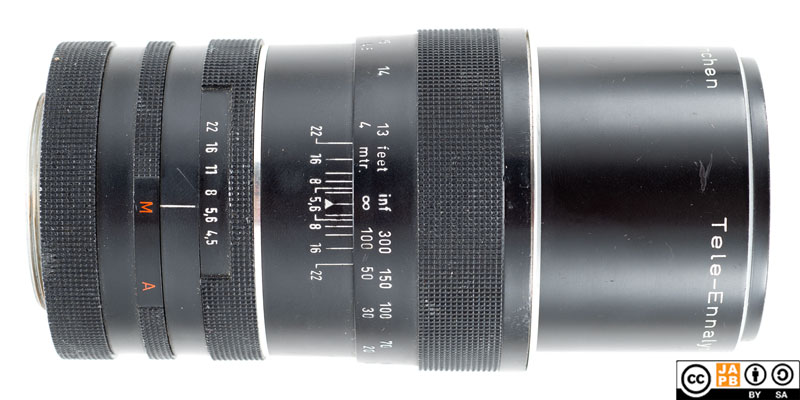Pekka Buttler, 02/2025
Quick summary
Enna München (also: Enna-Werk München) is one of the 1950s and 60s most prominent and innovative German optics companies. Enna München is especially well-known for being the West-German pioneer in developing retrofocus wide-angle lenses.

History of ENNA
ENNA München was founded in 1920 by Alfred Neumann in Munich. The name ENNA is a based on the German pronunciation of Mr. Neumann’s initials: enn–a1.
The company initially focused being an “optisches institut” (optical institute) and producing optical components for various applications. In effect this often meant manufacturing optics to be sold by major players under their own brands. During the war-years ENNA (alike practically all defence-relevant companies in Germany) was involved in developing and manufacturing optics for the war effort.
In 1945 the company’s plant was destroyed and the company relocated to Ebersberg – a small town 30 kilometres East of Munich. Also in 1945 the company’s founder Ing. Neumann died and his son-in-law Dr. Werner Appelt who had joined the company in 1927 took over the management of the company. While Dr. Appelt would append his name to the company’s full name, the name “ENNA” would remain the name shown on the company’s products. In 1948 the company would also return to its rebuilt factory in southern Munich2.
The postwar optics boom – especially the increased focus on high-quality interchangeable lens cameras – gave ENNA the chance to considerably up its game. Starting 1950 Enna started branding its lenses “Enna-Werk München” (ENNA-Works Munich) and theses lenses were extremely widespread. In fact, ENNA’s 1950s client list3 is the veritable who-is-who of the 1950s optics industry. By the late 1950s, ENNA was supplying lenses for several German camera brands, including Braun, Edixa, and Ihagee, as the demand for photography equipment surged.
Luckily for ENNA, they happened to have a number of exceptionally talented lens designers working for them during the 1950s, including Dr. Siegfried Schäfer as well as Johann Lautenbacher and Frank G. Back
Some of the key dates of the company’s heyday are:
• 1952: Release of the 35 mm f/4.5 Lithagon – the first West-German retrofocus lens. Upgraded to 35/3.5 in 1953 and 35 mm f/2.5 in 1956.
• 1954: Release of the first of many 85 mm f/1.5 Ennalyt Portrait lenses.
• 1956: Unveiling at PhotoKina of the 28 mm f/3.5 Ultra-Lithagon – the second company in the world to release a 28 mm retro focus lens.
• 1957: “Enna-Werk München” is replaced with “ENNA München” on lenses (and other products)
• 1958: Enna launches its ENNA Sockel (Enna Foundation) – an intermediate lens format supporting aperture automation based on the idea of slotting entire objectives into the same intermediate lens base. Adapters were initially available for M42, Exakta and Praktina systems.
• 1958: Enna launches the 35 mm f/1.9 Super-Lithagon, Initially only for the Enna Sockel, but later also for Exakta and M42 mounts. At the time it was the fastest 35 mm focal length lens for an SLR and would remain so until the launch of the 35 mm f/1.4 Nikkor in 1970.
• 1960: Patenting of the Enna Lithagon 24 mm f/4 – Practically simultaneous with the Carl Zeiss Jena 25 mm f/4 [data sheet] and three years ahead of the Carl Zeiss (West) Distagon 25 mm f/4. Several years ahead of the Japanese competition. This was the second ever4 24 mm retrofocus wide.angle for SLRs.
• 1961: Launch of the Enna Tele-Zoom 85-250mm f/4. This was – at the time – the world’s first tele zoom for 35 mm photography and only the second zoom altogether.
In 1962. Dr Appelt (Senior) dies and his son takes over management of the company. From the mid 1960s onward it was increasingly obvious that the West-German optics industry was losing ground to the Japanese (and more widely: Asian) competition. While Enna did a final marketing push in tandem with the 1972 Munich Olympics, the company had already started diversifying into other fields (most importantly: plastics). The company still exists today but has left the photo industry.
ENNA lens names:
Alike most German companies, ENNA had the habit of giving its lenses names that echoed the lens’ design or use-case.
In general, it is clear that Enna initially used the Lithagon name (including derivatives such as Ultra-Lithagon and Super-Lithagon) for all retrofocus lenses, and reserved the Ennalyt name for standard and short tele lenses while using the name Tele-Ennalyt for medium tele and longer lenses.
However, ENNA was forced to change its naming practice in the 1960s due to a trademark dispute. Thereafter one starts seeing a wider range of Enna-derived names (Ennalyt, Ennagon, Ennit…) for pretty much all kinds optics.
To complicate matters a bit, Enna lenses sold on the U.S. market were initially named Sandmar5 (instead of Lithagon, Ennalyt etc.) before starting to use the European names.


ENNA serial numbers
ENNA is one of those companies that used a running serial numbering scheme. While this in theory makes the dating of lenses easy, there are a number of complications.
First, I have not been able to find a document that would match serial numbers with years. The only hard fact I have managed to find is that the four millionth lens was manufactured in 1964.
Second, at some stage ENNA decided to no longer post the lens’ serial number on the lens. For example the 240 mm Tele-Ennalyt pictured above – it is impossible to find a serial number on it (maybe it’s on the inside somewhere).
Footnotes
- Another potential explanation to the ENNA-name is that it was the reverse of Alfred Neumann’s daughter’s name – Anne. ↩︎
- According to sources, the exact address of the plant was Konradinstrasse 3. As there still exists a postwar industrial building at that address, the reconstructed building likely is still there. ↩︎
- Including big names like: Alpa of Switzerland and Argus (U.S.) and many European camera manufacturers, including Balda, Bolta, Corfield, Dacora, Edixa, Franka, Ihagee, Leidolf, Lipca. At the same time ENNA also sold lenses for german rebranders Foto Quelle and Photo Porst. ↩︎
- That title goes to the ISCO Göttingen Westrogon 24 mm f/4 (patented 1956), which according to some sources was a half-baked design that crossed the border from East into west Germany in the mid 1950s. ↩︎
- This started with the Chicago company Geiss-America that started importing Enna lenses for use on the U.S. Argus cameras (see a brochure here). Geiss decided that these lenses should be named ‘Sandmar’. Because the name had a decent level of name recognition, Zeiss decided to continue using the name when it started importing Enna lenses for the Exakta as well. ↩︎